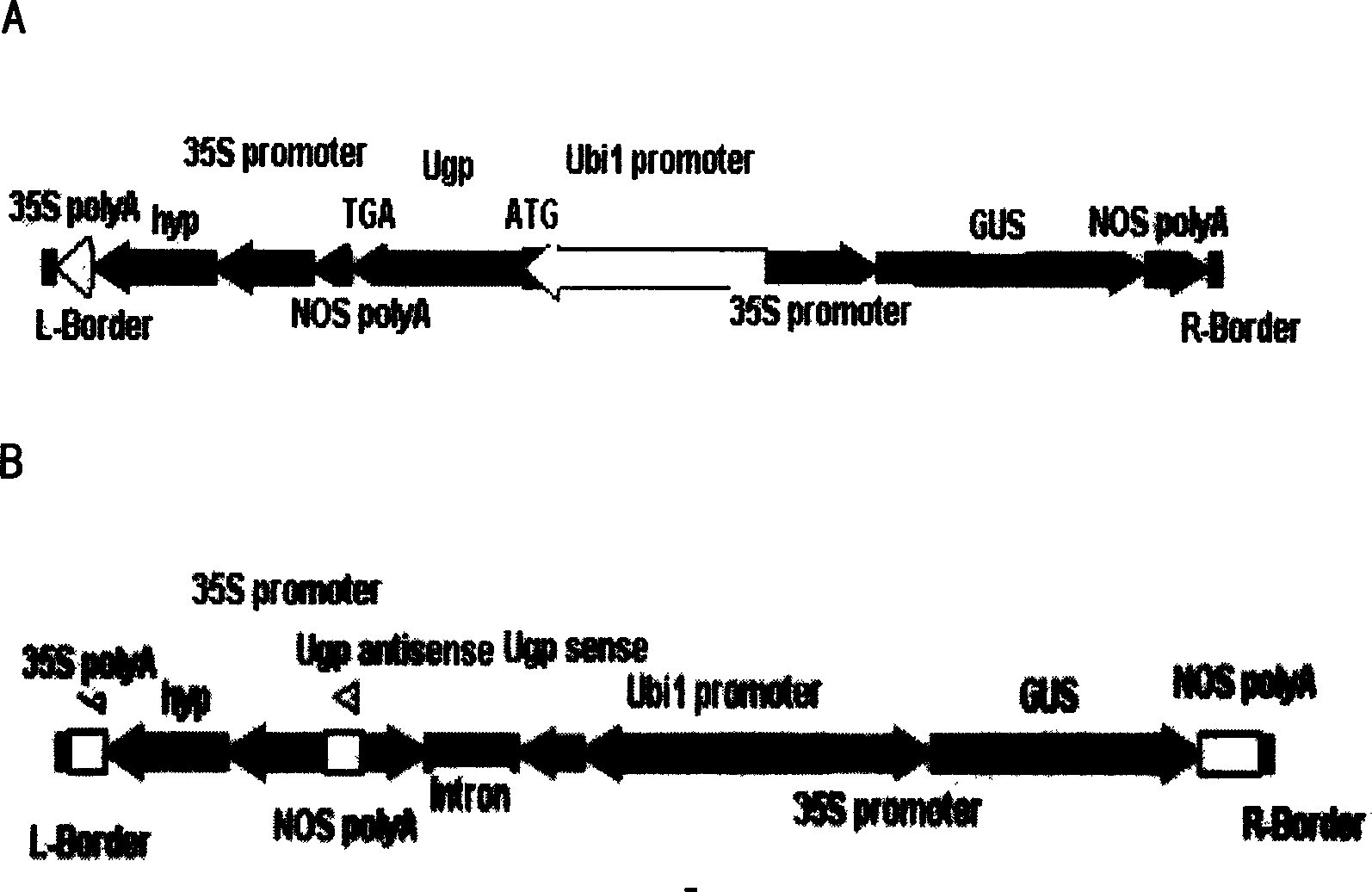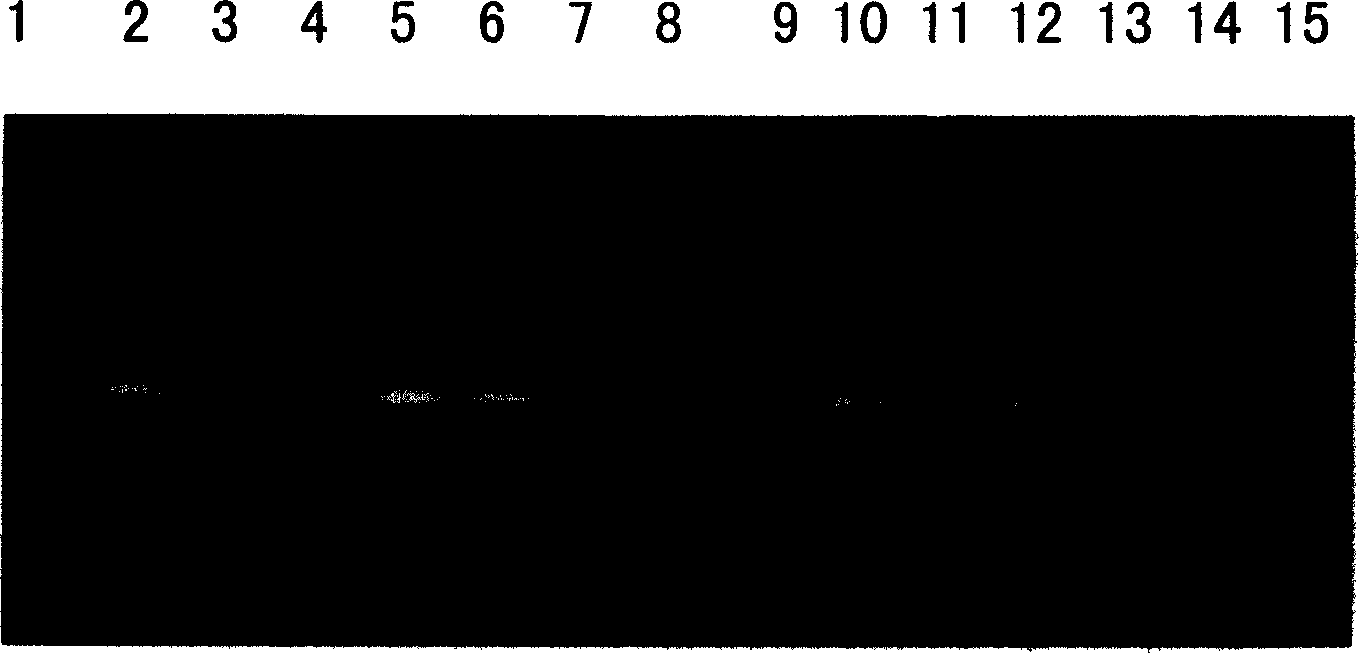Use of UDPG pyrophosphorylase in rice
A technology of uridine diphosphate and glucose coke, applied in the directions of application, biochemical equipment and methods, and introduction of foreign genetic material using a carrier, can solve the problems of changing rice pollen fertility, rice yield traits and other problems, and achieve complete abortion and plant growth. Tall, vigorous growth effect
- Summary
- Abstract
- Description
- Claims
- Application Information
AI Technical Summary
Problems solved by technology
Method used
Image
Examples
Embodiment 1
[0049] Example 1: Enhanced expression vector construction of uridine diphosphate glucose pyrophosphorylase gene
[0050] like figure 1 As shown in A, two primers were used in this experiment, the nucleic acid sequences of which were UGPF (5'-ATTGGATCCATGGCGGTCGCCGCCGACGTG-3') and UGPR (5'-CCGGGATCCTCAAAGATCCTCCGGACCGTTG-3'). Using UGPF / UGPR as a primer combination, using the plasmid cloned with the full-length gene of rice uridine diphosphate glucose pyrophosphorylase as a template DNA, by PCR (94°C 3min; 94°C 1min, 68°C 1min30s, 26cycles; 68°C 10min ) to synthesize and obtain the full-length gene of rice uridine diphosphate glucose pyrophosphorylase. Cut the uridine diphosphate glucose pyrophosphorylase gene with restriction endonuclease BamHI at 37°C, and connect it into the intermediate vector pU1301 digested with restriction endonuclease BamH1 and dephosphorylated by alkaline phosphatase , so that the uridine diphosphate glucose pyrophosphorylase gene is placed between t...
Embodiment 2
[0051] Example 2: RNAi vector construction of uridine diphosphate glucose pyrophosphorylase gene
[0052] like figure 1 As shown in B, four kinds of primers were used in this experiment, and their nucleic acid sequences are respectively:
[0053] F1 (5'-TCTCTCGAGTCTAGACCTTATTGTGATTC 3')
[0054]R1 (5'-ATTAAGCTTATTCACATGCTCATCAGGGAC 3')
[0055] F2 (5'-CCTCTCGAGCCTTATTGTGATTCAAATTGAG 3')
[0056] R2 (5'-GAAAAGCTTGAATTCATTCACATGCTCATC 3')
[0057] A. The partial coding region of the uridine diphosphate glucose pyrophosphorylase gene is forward inserted into the first polylinker site of the pHANNIBAL vector:
[0058] 1. Amplification of the target fragment Using the primer pair F1 / R1 to amplify the coding region of the uridine diphosphate glucose pyrophosphorylase gene;
[0059] 2 Digestion and ligation The purified PCR product was double digested with Xho I and EcoR I and then ligated to the same double digested pHANNIBAL vector;
[0060] 3 Identification of recombinant pl...
Embodiment 3
[0067] Example 3: Agrobacterium-mediated transformation and screening of transgenic rice plants
[0068] A. Callus induction
[0069] 1. Peel off the glumes and glumes of the seeds, select mature and plump rice seeds, and put them into a 50ml centrifuge tube.
[0070] 2. Wash 3 times with 30ml distilled water, soak in 70% ethanol for 2min, wash 3 times with distilled water, and then use 0.15% HgCl 2 Soak for 15-20min while shaking at 100rpm.
[0071] 3. Open the centrifuge tube on a sterile table and pour off the HgCl 2 , After washing the seeds with sterile water for 4 or 5 times, pour the seeds on sterilized filter paper and let them stand for about 1 hour.
[0072] 4. Put the seeds into N6 solid medium (10 grains / 25ml / bottle), with the embryos facing up or in contact with the medium, culture in the dark at 28° C. for 4 weeks, and induce rice callus.
[0073] 5. Observe the induced callus, separate the light yellow, dense embryogenic callus from the small shield, transfe...
PUM
 Login to View More
Login to View More Abstract
Description
Claims
Application Information
 Login to View More
Login to View More - R&D
- Intellectual Property
- Life Sciences
- Materials
- Tech Scout
- Unparalleled Data Quality
- Higher Quality Content
- 60% Fewer Hallucinations
Browse by: Latest US Patents, China's latest patents, Technical Efficacy Thesaurus, Application Domain, Technology Topic, Popular Technical Reports.
© 2025 PatSnap. All rights reserved.Legal|Privacy policy|Modern Slavery Act Transparency Statement|Sitemap|About US| Contact US: help@patsnap.com



